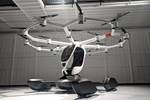New Hartzell Propeller director leads the way for advanced air mobility
Mitch Heaton, director of business development and new technology will further the company’s involvement in delivering composite propellers for eVTOL, eSTOL, electric, hybrid and hydrogen aircraft.

Photo Credit: Getty Images
Hartzell Propeller (Piqua, Ohio, U.S.) has appointed Mitch Heaton as director, business development and new technology to further the company’s program involving advanced air mobility (AAM). His focus will be on developing propellers for electric vertical takeoff and landing (eVTOL), electric short takeoff and landing (eSTOL), electric-, hybrid- and hydrogen-powered aircraft.
Hartzell has 30 years of experience in the design and manufacturing of structural composite blades. The Hartzell ASC-II, for example, consist of “carbon fiber laminates integrated into a co-molded stainless steel shank” according to the company’s website. The company expects to incorporate a blend of sophisticated engineering analytics, certification skills and world-class manufacturing technologies as it works closely with several OEMs within these emerging industries to fine-tune its propeller applications. Hartzell says it has already dedicated tens of thousands of engineering and development hours to electric, hybrid and hydrogen powered aircraft since 2019, and it continues to make advancements in tooling, manufacturing processes and lightweighting materials.
“Mitch Heaton has experience leading strategy and business development across multiple industries, with aviation and aerospace often as a focus,” Hartzell Propeller president JJ Frigge, says. “His efforts have included design of connection systems for aircraft, growing unmanned aerial ecosystems and collaborating with leaders of global aerospace and defence companies and organizations.”
Heaton is a member of the General Aviation Manufacturer's Association (GAMA, Washington, D.C., U.S. and Brussels, Belgium) Electric Propulsion Innovation Committee, and several subcommittees. He also serves as a member of the Emerging Technologies Committee of the National Business Aviation Association (NBAA, Washington, D.C., U.S.).
He is a graduate of the Raj Soin College of Business at Wright State University, where he later served as director of development and external relations in the College of Engineering and Computer Science. He has also been vice president of economic development for the Dayton (Ohio) Development Coalition and executive vice president of growth strategies for Woodard Development. He was named to Dayton Business Journal’s 40 Under 40 list in 2017, has served on the board of directors for the Ohio Economic Development Assn. and he is a member and past president of the Engineer’s Club of Dayton.
Related Content
-
Materials & Processes: Resin matrices for composites
The matrix binds the fiber reinforcement, gives the composite component its shape and determines its surface quality. A composite matrix may be a polymer, ceramic, metal or carbon. Here’s a guide to selection.
-
Materials & Processes: Fibers for composites
The structural properties of composite materials are derived primarily from the fiber reinforcement. Fiber types, their manufacture, their uses and the end-market applications in which they find most use are described.
-
Materials & Processes: Composites fibers and resins
Compared to legacy materials like steel, aluminum, iron and titanium, composites are still coming of age, and only just now are being better understood by design and manufacturing engineers. However, composites’ physical properties — combined with unbeatable light weight — make them undeniably attractive.















.jpg;maxWidth=300;quality=90)
